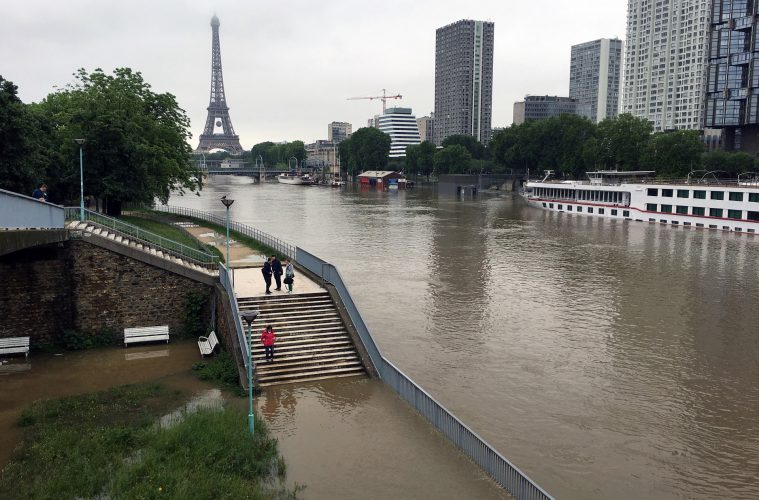By Stuart Richardson
Every day, on my way to school, I cross the Pont Saint-Louis in central Paris. The paved footbridge connects the city’s two inhabited islands, Ile de la Cite and Ile Saint-Louis, offering stunning views of the flying buttresses of Notre-Dame Cathedral. Here, musicians busk for a pretty penny: Tourists and locals, by the hundreds, traverse the walkway daily.
The beginning of February must have been a coup for the street performers on Pont Saint-Louis as there were noticeably more people loitering on the bridge. In fact, all along the banks of the Seine, large crowds gathered to take pictures of the river, which had swelled to an incredible 5.87 meters above its normal level.
The floods forced city officials to close several Metro stations and suspend services on a regional train. Further out, in the suburbs and provincial villages surrounding Paris, rivers overran their banks, inundating entire neighborhoods.
For local officials, the floods are a bellwether for Paris’ future in an ever-warming world.
“In the course of eighteen months, we have experienced two very significant floods…and also four peaks in heat waves. We have truly entered climate change,” Anne Hidalgo, the mayor of Paris, told an evening radio program earlier this month.
Like Paris, most inland cities have not been key sites of scientific inquiry on the effects of climate change. However, it is evident that climate change-related risks to inland municipalities, most notably floods, are a grave concern. Indeed, negligence on this issue can incur high financial and human costs.
The Future of Flooding
In June 2016, unprecedented torrential rain spurred flooding across continental Europe and the British Isles. The Seine rose an astonishing 6.3 meters, its third highest historical peak, in a matter of days. The resulting floods cost French insurers between 900 million and 1.4 billion euros. More than twenty people across Europe died in the floodwaters.
A team of scientists at Oxford University and the Royal Netherlands Meteorological Institute determined that in France that summer the probability of precipitation extremes had increased by roughly eighty percent over the historical average. In other words, global warming conditioned the storms and subsequent flooding.
“Climate change will clearly have an impact on flood risk,” says Maurizio Savina, Director of International Flood Model Management at RMS, a leading catastrophe risk modeling and analytics firm based in Silicon Valley. “With each additional degree of Celsius, air is able to transport seven percent more moisture, which potentially can convert into higher precipitation intensities.”
What remains less certain, however, is how and where exactly this surplus water vapor will change regional climates.
“It is not a linear, positive relationship between temperature, rainfall, and flooding,” Savina warns. Although changes to the water cycle and atmospheric composition are induced by global warming, they may have opposite effects that counteract one another. To account for all possible scenarios, Savina’s team of experts must run over 50,000-year simulations for a single probabilistic model, which accounts for weather conditions in just the next one to five years.
“As of today, we need to do more research in understanding where there could be more rainfall and where there will be less,” he says. “Clearly, there is going to be a shift, but it is very difficult to quantify.”
Still, even slight increases in seasonal precipitation could inundate cities as the amount of precipitation is not the only factor which determines a flood. The surface’s ability to absorb or transmit the excess accumulation of water also influences flood conditions. Proper drainage systems and ample green space are therefore essential to mitigating risk.
But inland cities around the globe have largely failed to maintain both. The reckless development of flood zones and shrinking of natural space is symptomatic of a culture of negligence in urban planning. Concrete, brick, and other impermeable surfaces can only channel water, often inefficiently. Ample vegetation is needed to soak up most precipitation. Without this, the result can be flash flooding during episodes of prolonged, heavy rainfall.

Texas National Guardsman assist Houston residents during unprecedented flooding last year. [U.S. Department of Defense]
“It is quite impossible to build 100 percent physical protection,” argues Savina, whose firm provides its clients with cost-benefit analysis of future flood risk. “You always need to be ready for very rare events that could overwhelm flood protections. You need to have financial measures that take over the last portion of the risk.”
Most governments in developed economies offer flood insurance. But high premiums (and a certain level of hubris) often dissuade homeowners and businesses from utilizing these programs. In Houston, for example, 80 percent of households were not protected against flood damage prior to Hurricane Harvey.
Global warming is changing climate. Its impact will burden not only coastal cities but also urban municipalities located further inland. While weather remains beyond human control, government officials and developers can do more to better prepare for future climatic conditions. This requires building better drainage systems and retrofitting infrastructure along with developing financial safety nets in case of disaster.
Savina sums up the preferred mindset simply: “We need to design today for tomorrow.” ♦
Stuart Richardson is the editor-in-chief of the Paris Globalist. He is pursuing a graduate degree in international security at Sciences Po.

